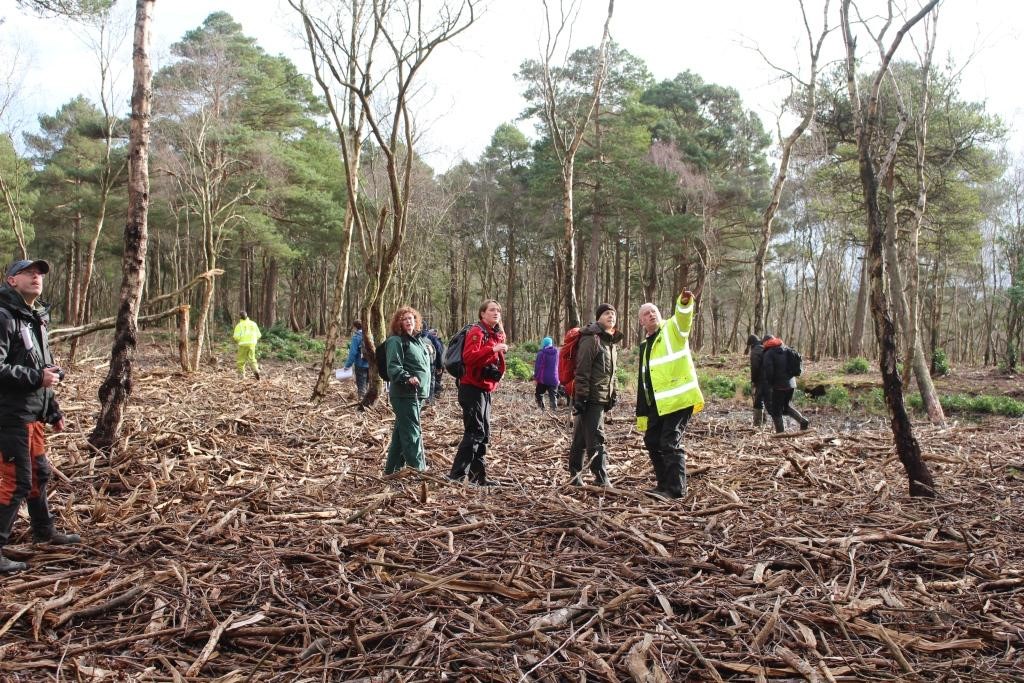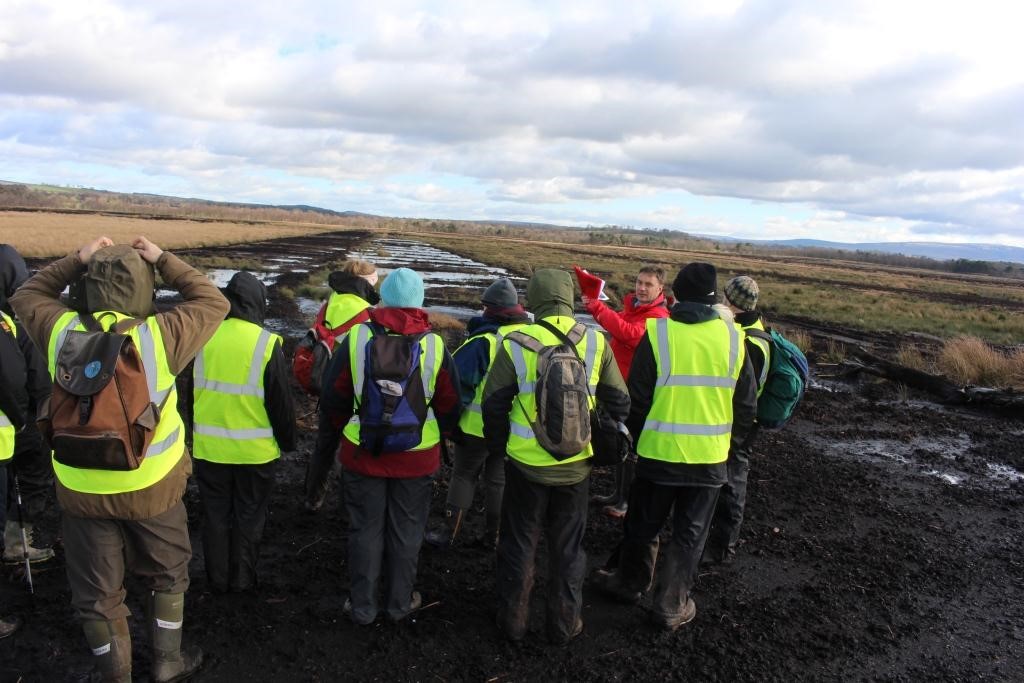Within the last month, 57 professionals with an interest in peatland restoration have taken part in a series of workshops on lowland raised bog peatland restoration techniques organised by the Cumbria BogLIFE project.*
The workshops focussed on site visits to two degraded but contrasting bogs – Roudsea Wood & Mosses Special Area of Conservation (SAC) in the south of the county and Bolton Fell Moss SAC in the north east.
Roudsea Wood & Mosses
 Roudsea Wood & Mosses is a vegetated, but degraded bog. The area being restored has suffered historic extensive, small-scale peat cutting around the edges of the bog and has associated drainage ditches across, which has led to a drying out of the peat followed by a change in and loss of diversity of the bog communities – including dense rhododendron infestation.
Roudsea Wood & Mosses is a vegetated, but degraded bog. The area being restored has suffered historic extensive, small-scale peat cutting around the edges of the bog and has associated drainage ditches across, which has led to a drying out of the peat followed by a change in and loss of diversity of the bog communities – including dense rhododendron infestation.
The Cumbria BogLIFE project is removing the trees and rhododendron and restoring water levels across 119ha. On a visit to the site we met the two contractors undertaking some of the restoration work this winter.
Anthony Lambert from TreeClear described how their bespoke machine, with purpose-built flailing head, had cleared the dense rhododendron efficiently and effectively. The dense mat of cuttings left across the site will help prevent re-growth and provide a matrix upon which Sphagnum mosses can re-colonise.
Simon Bland, of Barker and Bland talked us through their approach to the construction of bunded peat cells (using in situ non-degraded ‘wet’ peat), the re-profiling of cut peat faces and the blocking of drains and ditches using peat dams (again, using in-situ non-degraded ‘wet’ peat). A live demonstration provided an opportunity for delegates to observe the technique in action and see the ‘wet’ peat being worked skilfully by the machine operator into bunds.
Bolton Fell Moss
 Bolton Fell Moss has been extensively milled for many decades and the 375ha bog now has a largely bare-peat surface. This raised bog is now shaped more like a doughnut than a dome, so there’s a challenge in restoring water levels to ‘near ground level’ across the whole site. The vast areas of bare, dark peat provide a harsh and unnatural environment for Sphagnum to grow (being hot and dry in summer and experiencing freeze-thaw in winter), so creative techniques are required. The site had been split into ‘milling fields’ during peat extraction, and each of these is now being restored independently of each other as ‘mini-bogs’.
Bolton Fell Moss has been extensively milled for many decades and the 375ha bog now has a largely bare-peat surface. This raised bog is now shaped more like a doughnut than a dome, so there’s a challenge in restoring water levels to ‘near ground level’ across the whole site. The vast areas of bare, dark peat provide a harsh and unnatural environment for Sphagnum to grow (being hot and dry in summer and experiencing freeze-thaw in winter), so creative techniques are required. The site had been split into ‘milling fields’ during peat extraction, and each of these is now being restored independently of each other as ‘mini-bogs’.
Meeting the contractors out on site gave delegates an opportunity to hear first-hand about the innovative approaches being trialled and used by Cumbria BogLIFE to restore 280ha of the bog.
Johnny Rook, of OpenSpace, showed us an area they restored last winter, where a number of different techniques of re-introducing bog vegetation were trialled. It is early days, but it appears that the different approaches are producing differing results. Close monitoring will provide longer-term evidence.
Barker and Bland is working on 50ha of the bog this winter and Simon joined us on site to describe their approach to managing the hydrology and a quite different technique they are trialling for re-introduction bog vegetation using a ‘new’ mix as a nurse-crop and mulch.
Delegates attended from a wide variety of organisations from the UK and Europe, bringing a wealth of experience and useful discussion sharing knowledge, experience and ideas. Following this the Cumbria BogLIFE project team are now planning our mid-project conference taking place in early October 2016.
For further information contact:
Tania Crockett, Cumbria BogLIFE Communications Officer
Email: tania.crockett@naturalengland.org.uk
Tel: 07881 255343
Web: www.gov.uk/government/publications/cumbrian-bogs-life-project
Facebook: www.facebook.com/cumbriasnnrs
Twitter: www.twitter.com/necumbria
*Cumbria BogLIFE is a five year Natural England project that is restoring three lowland raised bog sites within the county of Cumbria:
The project, which has been 50% match-funded by the EU LIFE+ Programme, is directly restoring 507 hectares (ha) of degraded raised bog habitat. As each of the project sites are part of wider areas of bog, this will result in improvements to 751 ha of the Natura 2000 network.
The project is delivering highly innovative habitat restoration and monitoring techniques across the three raised bog sites and using the work to illustrate a range of techniques to managers of similar habitats and academic audiences, both locally and across the European Community.










